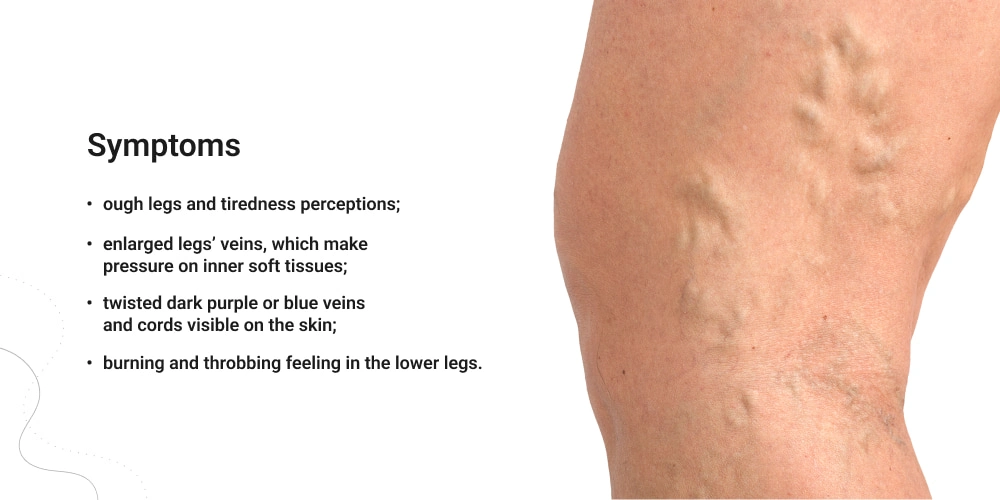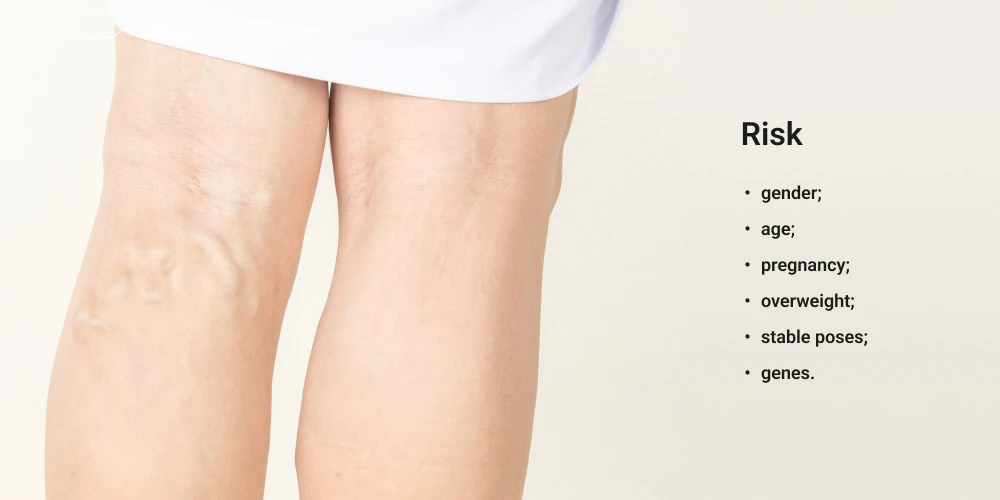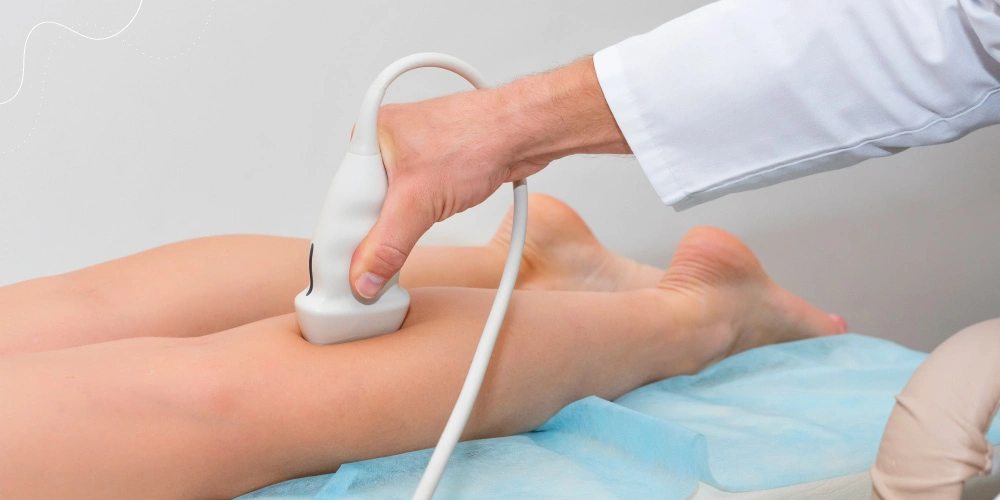Varicose in leg veins is a medical and cosmetological problem. However, varicose attacks the male population due to the disease’s symptoms. Women with spider veins feel discomfort, refusing to wear short dresses or skirts. At the same time, they suffer from painful effects provoked by the deteriorated blood circulation in the lower limbs.
According to clinical surveys, approximately 23% of Americans are diagnosed with varicose vein syndrome. This chronic disease affects females and males aged 40 to 80 years. This ailment’s main triggers represent the gradual loss of vein elasticity and decreased muscle strength.
Unfortunately, treatment approaches are restricted, and most cases are relieved thanks to surgical manipulations. The cutting-edge varicose recovery techniques make surgery proceedings safe and painless.
To minimize the risks of late phased disease progress, any person with slight signs of spider vein or respective assumptions should call for qualified medical consultation and examination, particularly a vein ultrasonic investigation.
What is a Varicose Vein?
Varicose veins imply a deteriorated blood circulation in veins due to a range of factors. The anatomical theory stresses that blood circulation from body cells reaches the heart through veins with elastic walls and muscle fibres. Blood pumping becomes complicated when lower limbs are disabled to support a reverse circulation process.
Legs are a zone in which patients could observe enlarged spider veins, but varicose could occupy the remaining blood vessels going to the heart. Upon plenty of clinical tests, deteriorated vein walls are detected in alimentary canals, eye retina, rectum, and spermatic channels.
Based on statistical fact-findings, nearly 1 in 4 Americans know what pain in the vein and visible spider blood vessels in the legs are. The forecasted perspectives regarding the disease progress are not positive. Due to varicose-stimulating factors, the detected ailment of twisted veins could increase to 6% by 2025. More precisely, varicose triggers are associated with pandemic restriction consequences of remote work and stable long-term sitting.
Spider Veins: Symptoms
To understand the genuine sense of the disease’s nature, you need to investigate its symptoms and remove all assumptions about the related vein dysfunctions. So, varicose vein syndrome is characteristic of the following signs:
- rough legs and tiredness perceptions;
- enlarged legs’ veins, which make pressure on inner soft tissues;
- twisted dark purple or blue veins and cords visible on the skin;
- burning and throbbing feeling in the lower legs.
Stages of Varicose Veins
Varicose veins are dangerous diseases that lead to thrombosis and fatal consequences. The Clinical Etiology Anatomy Pathology determines seven stages of the varicose progression:
- Stage 0. A disease has attacked vein anatomy, but visible signs are not identified. People feel heavy legs and itching reactions. Seat poses provoke pressure in the veins of the legs. At night, patients with 0-staged varicose syndrome could perceive convulsions. Typically, such patients explain the primary signs of tiredness or stress;
- Stage 1. Along with 0-staged symptoms, patients notice tiny cords of veins under the skin;
- Stage 2. This stage is considered a genuine initiation of the disease’s progress. The enlarged spider veins are visible, and people could feel slight painful reactions. After prolonged walking in tight shoes or a long day sitting, the health state gets worse;
- Stage 3. Varicose of veins comprises the disease signs from the previous stages. The most irritating symptom is edemas in the lower legs. Inflammatory and enlarged veins provoke deteriorated blood and liquid circulation; therefore, edemas become everyday adverse effects;
- Stage 4. Modifications continue, and you may observe them on your skin clearly. Varicose drastically changes skin structure. Patients notice cords, edemas, bleaching, or redness spots;
- Stage 5. Veins are completely losing their elasticity. Ulcerations on the skin deepen and form scars after treatment;
- Stage 6. Treatment of scars is less effective, and ulcerations develop infection-suitable environments.
Risk Factors and Causes of Varicose Veins
The pathological disease could be treated and prevented if you know the risks and causes of varicose veins:
- gender;
- age;
- pregnancy;
- overweight;
- stable poses;
- genes.
Based on the general clinical studies, varicose of lower limbs’ veins affect the following in-risk categories, which should carefully treat their cardiovascular impairments.
The disease risk groups should be careful and call for professional medical consultations when the first symptoms match the initial stages.
The risk groups are the potential patient categories whose physiological, genetic, or anatomical particularities make them weak to varicose signs:
- Gender. According to identified clinical statistics, women more frequently suffer from pathological effects of the deteriorated vein walls. Hormonal disbalances during pre-menstrual periods, pregnancy, or menopause are core triggers of varicose. Hormone treatment to control birth also increases varicose vein syndrome risks;
- Age. The aging process provokes the depreciation of human physiological functions. Veins and muscles could not resist prolonged physical exercises. Damaged blood circulation channels do not execute their functions and form inflammatory cords;
- Pregnancy. Pregnant women detect numerous adverse reactions which disturb normal lifestyle activities. Increased blood volume and enhanced liquid consumption threaten to wear leg valves in the third trimester;
- Overweight. Excess weight increases pressure on blood circulation valves in lower limbs;
- Stable poses. Due to high gravity or pressure states, sitting or standing poses are drastically dangerous for a long-term period;
- Genes. Vein leg pain will probably be diagnosed if a family member has varicose symptoms.
Causes of Varicose Veins
Any disease’s nature is clear if you know its triggers better and could prevent their negative effects. The pathological factors of varicose veins include:
- non-mobile lifestyles;
- water imbalance;
- weak muscles.
The particular risk groups could be expanded due to the neglected attitude to your vein health. Thus, a comprehensive answer to the question “What causes spider veins?” depends on your knowledge about the pathological triggers:
- Non-mobile lifestyles. Remote jobs related to computer engineering, education, or economic analysis trigger vein deterioration. The prolonged pressure or relaxation states reduce valve elasticity;
- Water imbalance. Decreased water consumption leads to a low blood-liquid ratio and reduces its ability to transmit oxygen to cells. Juice, tea, coffee, or freshers could not be qualified drinks. They perform nutrition functions for blood;
- Weak muscles. Absences of physical exercises deteriorate muscle fibres and make them less resistant to neurological or cardiovascular disorders. As such, nerve and muscle stimulations can not pump blood through valves, conversely to gravity principles.
How to Treat Varicose Veins?
The therapy program for varicose-positive patients includes several effective methods. Each technique is related to surgical interventions using innovative approaches in varicose treatment. Therefore, patients should realize vein leg pain is not an easy-to-recover disease if you apply bandages or sedative medication.
Phlebectomy
These surgical manipulations are prescribed to treat late-stage cases, and patients face high risks of thrombosis disease. The procedure is pretty complicated and requires professionality and experience to achieve the expected results. The negative consequences of unskilled surgical interactions increase the chances of receiving complementary neurological disorders.
Endovenous Laser and Radiofrequency Treatment of Lower-limb Varicose
This varicose treatment technology refers to safe surgical methods. Lasers and radio frequencies renovate the valve elasticity and fill the deteriorated areas to stimulate normal blood circulation and reduce thrombosis risks.
Opposite to phlebectomy proceedings, patients could supervise the process and do not feel painful reactions in veins when surgeons perform specific manipulation on legs.
Mini Phlebectomy
This surgical method resembles the previous technique due to laser intervention principles. However, mini phlebectomy uses lasers to remove inflammatory and enlarged valves and suspend the deterioration processes.
This procedure is almost safe and lasts up to 40 minutes. At the same time, patients are denied to request this varicose treatment method if they are subject to the following situation:
- pregnancy or lactation period;
- blood-related pathologies;
- motor dysfunctions;
- infections;
- thrombophlebitis.
Varicose Vein Sclerotherapy
The treatment method does not foresee direct surgical manipulations. In particular, the treating doctor applies the injection of a special solution, which should eliminate varicose changes in veins. The procedure is safe, and any phase of the disease progression is permitted for irritating the lining of the blood vessels and sticking them together.
Varicose Veins Prevention
Despite a sudden growth of diagnosed spider vein disease, you may execute preventive measures to reduce the appropriate risks:
- Practice short breaks during the working days and do little physical exercise;
- Consume enough amount of water;
- Modify a dietary formula by increasing the vegetable and fruit ratio;
- Choose comfortable shoes and refuse to wear heels for everyday occasions;
- Keep following the walking rule of about 10k steps a day. Regular outdoor activities help you forget what causes varicose veins;
- Call for the therapy consultation once you notice the initial stage symptoms;
- Apply massage therapy and contrast shower hydrotherapy for legs.
- Go in for sports activities like swimming, walking, jogging, yoga, and pilates. The main principle for workout complex choice is to prefer active physical exercises which stimulate blood circulation and strengthen muscles.
Do not Neglect Lower-Limb Spider Veins Treatment to Avoid Emergencies
Enlarged veins with pulsing pains and progressive ulcerations are not a verdict for people who start treating procedures in time. Varicose-diagnosed patients should realize that self-relief methods are not effective and hazardous to their life and health. Comprehensive Lone Star Neurology clinical surveys and medical tests build the most appropriate treatment technique and accessible rehabilitation activities to prevent future analogous effects. Moreover, you need to avoid varicose-provoking factors if you do not want to find the answers to the question, “Are varicose veins painful?”
FAQs:
-
What causes varicose veins?
Varicose veins result from common triggers which deteriorate blood circulation and provoke thrombosis risks, including:
– long-term sitting or standing poses without regular physical activities;
– overweight and high glycemic indexes;
– female hormonal disbalances;
– age-accompanying factors like depreciated valves and muscles;
– genetic particularities.
-
How do you treat varicose veins?
Unfortunately, medication or physiotherapy methods are less effective for varicose-diagnosed patients. Only surgical manipulation could renovate the abnormal blood circulation processes. The laser and radiofrequency treatment techniques are the best methods to suspend any stage of the disease progress and do not negatively affect the patient.
-
Can varicose veins go away?
In-time surgical manipulations selected by clinical surveys, correct diagnosis conclusions, and patient’s state could remove varicose effects. However, you need to maintain the prevention measures to reduce potential risks in the future.
-
How do you get varicose veins?
Aging, female hormonal changes, pregnancy, overweight, stable poses, and family health history discover clear clues about the chances of suffering from insufficient vein elasticity and varicose effects.
-
How can I prevent varicose veins in my legs?
To prevent lower-limb varicose, you should combine stable poses with scheduled active breaks, physical exercises, water balance, improved dietary formulas, massage therapy, and periodic diagnostic consultations.
-
Are varicose veins painful?
The late stages of the varicose vein progression provoke severe pulsing pains. These painful reactions could become intense due to high pressure and increasing deterioration of vessel walls.













Please, leave your review
Write a comment: